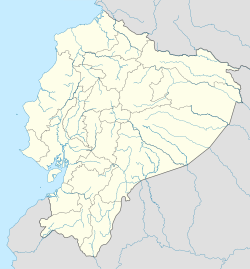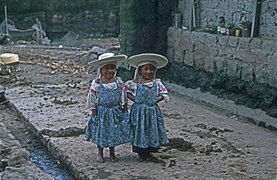
Cuenca, officially Santa Ana de los Ríos de Cuenca, is an Ecuadorian city, head of the canton of the same name and capital of the province of Azuay, as well as its largest and most populated city. It is crossed by the Tomebamba, Tarqui, Yanuncay and Machángara rivers, in the south-central inter-Andean region of Ecuador, in the Paute river basin, at an altitude of 2,538 meters above sea level and with a temperate Andean climate averaging 16.3 °C.
Ecuador is a multicultural and multiethnic nation, with the majority of its population is descended from a mixture of both European and Amerindian ancestry. The other 10% of Ecuador's population originate east of the Atlantic Ocean, predominantly from Spain, Italy, Lebanon, France and Germany. Around the Esmeraldas and Chota regions, the African influence would be strong among the small population of Afro-Ecuadorians that account for no more than 10%. Close to 80% of Ecuadorians are Roman Catholic, although the indigenous population blend Christian beliefs with ancient indigenous customs. The racial makeup of Ecuador is 70% mestizo, 7% Amerindian, 12% White, and 11% Black.
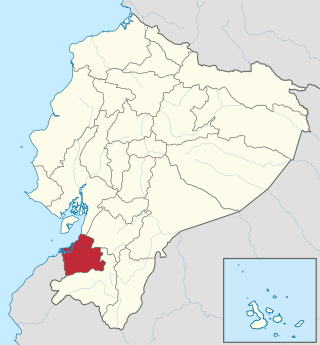
El Oro is the southernmost of Ecuador's coastal provinces. It was named for its historically important gold production. Today it is one of the world's major exporters of bananas. The capital is Machala.

Imbabura is a province located in the Andes of northern Ecuador. The capital is Ibarra. The people of the province speak Spanish, and a large portion of the population also speaks the Imbaburan Kichwa variety of the Quechua language.
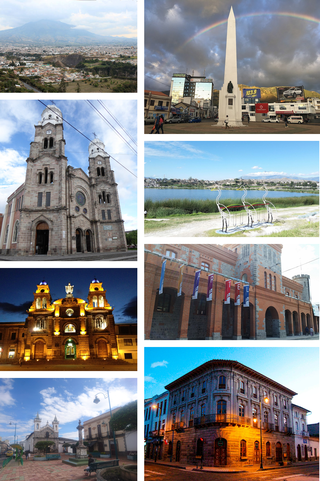
Ibarra is a city in northern Ecuador and the capital of the Imbabura Province. It lies at the foot of the Imbabura Volcano and on the left bank of the Tahuando river. It is located about 70 kilometres (43 mi) northeast of Ecuador's capital Quito.

Riobamba is the capital of Chimborazo Province in central Ecuador, and is located in the Chambo River Valley of the Andes. It is located 200 km (120 mi) south of Ecuador's capital Quito and situated at an elevation of 2,754 m.

Quechua people or Quichua people may refer to any of the indigenous peoples of South America who speak the Quechua languages, which originated among the Indigenous people of Peru. Although most Quechua speakers are native to Peru, there are some significant populations in Ecuador, Bolivia, Chile, Colombia, and Argentina.

Cayambe is a canton in the northeast of the province of Pichincha, in northern Ecuador, South America. The canton is named after the Cayambe, a 5,800-meter-high snow-covered stratovolcano in the east of the canton. The main part of the canton occupies the eastern portion of the Pisque river basin and is surrounded by volcanoes.
Guayllabamba is a small agricultural town located 29 kilometers northeast of the city of Quito in northern Ecuador. In the 2001 census, the parish had a population of 12,227. The elevation is 2,142 metres (7,028 ft) above sea level.
Pambamarca is an eroded stratovolcano in the Central Cordillera of the northern Ecuadorian Andes in Pichincha Province. it is 25 miles (40 km) northeast of Quito. The summit is at an elevation of 4,062 metres (13,327 ft).

Kichwa is a Quechuan language that includes all Quechua varieties of Ecuador and Colombia (Inga), as well as extensions into Peru. It has an estimated half million speakers.

Cayambe Coca National Park is a national park in Ecuador located along the Equator about 38 km (24 mi) from Quito. The park encompasses an area of 4,031.03 km2.

The Cañari are an indigenous ethnic group traditionally inhabiting the territory of the modern provinces of Azuay and Cañar in Ecuador. They are descended from the independent pre-Columbian tribal confederation of the same name. The historic people are particularly noted for their resistance against the Inca Empire. Eventually conquered by the Inca in the early 16th century shortly before the arrival of the Spanish, the Cañari later allied with the Spanish against the Inca. Today, the population of the Cañari, who include many mestizos, numbers in the thousands.

El Quinche is a city of Ecuador, in the Pichincha Province, about 22 km (14 mi) in a straight line distance northeast of the city of Quito. The city, administratively a rural parish of the canton of Quito, is located in the valley of the headwaters of the Guayllabamba River, to the west of Pambamarca. It borders Cayambe Canton to the northeast.
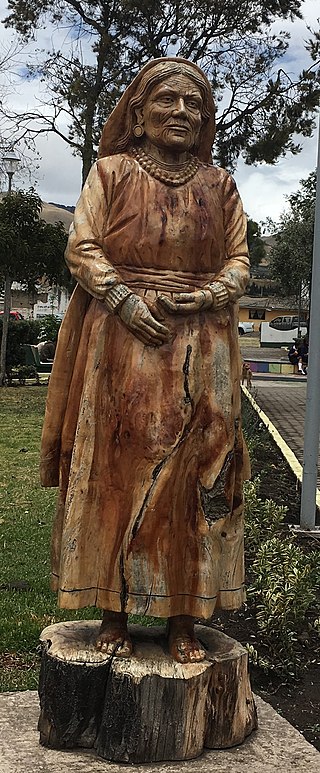
Dolores Cacuango, also known as Mamá Doloreyuk, was a pioneer in the fight for indigenous and farmers rights in Ecuador. She stood out in the political arena and was one of the first activists of Ecuadorian feminism, between '30s and '60s. She founded the Federación Ecuatoriana de Indios (FEI) in 1944 with the help of Ecuador's Communist Party.

The Otavalos are an indigenous people native to the Andean mountains of Imbabura Province in northern Ecuador. The Otavalos also inhabit the city of Otavalo in that province. Commerce and handcrafts are among the principal economic activities of the Otavalos, who enjoy a higher standard of living than most indigenous groups in Ecuador and many mestizos of their area.

The Hacienda Guachalá is known as the oldest hacienda in Ecuador, and the most important hacienda until the middle of the 20th century. The oldest buildings date from the year 1580, and at its apogee comprised more than 21000 ha. It hosted members of the French Geodesic Mission, Gabriel García Moreno, an Ecuadorian former president; Neptalí Bonifaz, first president of Central Bank of Ecuador. Cristóbal Bonifaz, founder member of the Charles Darwin Foundation, Diego Bonifaz, a former Mayor of Cayambe during 2000-2011 period, and Rafael Bonifaz, former Elastix distro community manager.

The Saraguro is a people of the Kichwa nation most of whom live in Saraguro Canton in the Loja Province of Ecuador. Although most now speak Spanish, Runashimi or Kichwa, a Quechua dialect, is also spoken and language revitalization efforts are being implemented. Likewise, the Saraguro have retained much of their land, customs and traditional dress. According to the INEC's 2010 population census, the total population of Saraguro canton is 30,183, but that total includes both the Indigenous and non-Indigenous people living in Saraguro.
The Inca-Caranqui archaeological site is located in the village of Caranqui on the southern outskirts of the city of Ibarra, Ecuador. The ruin is located in a fertile valley at an elevation of 2,299 metres (7,543 ft). The region around Caranqui, extending into the present day country of Colombia, was the northernmost outpost of the Inca Empire and the last to be added to the empire before the Spanish conquest of 1533. The archaeological region is also called the Pais Caranqui.
Rumicucho or Pucara de Rumicucho is an archaeological site of the Inca Empire in the parroquia of San Antonio de Pichincha, in Quito Canton, Pichincha Province. Ecuador. Rumicucho is a pucara located 23 kilometres (14 mi) in a straight-line distance north of the city of Quito at an elevation of 2,401 metres (7,877 ft). Rumicucho in the Quechua language means "stone corner", perhaps referring to its strategic location between the territory of the Yumbo people to the east and the chiefdoms of the Pais Caranqui to the north.

